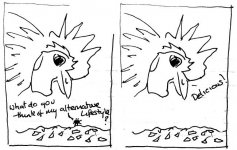chrismahon said:
A coop has to be empty for 9 months before all the red mite have died Rick. Presumably it takes that long because they eat each other. Based on my experiments they quickly die above 55C. An early indicator of their presence is ants as they eat red mite amongst other little bugs.
Yeah! I thought I had wiped them out when I cleaned the run but there was a gap under the construction of the shelf (I found later) where most of them were camped out. I think they just starve to death after 9 months if they cant get at a bird for a meal but, in nature, there would be a good chance of a bird roosting nearby in that time (next summer even) and then they are back in business.
They are interesting, and knowing the enemy is always key to winning! I think this is how they conduct themselves and it fits with all of the successful ways to control them that I have heard of (outside of insecticides and things that make chicken blood unpalatable in one way or another):
It starts with a single adult mite out looking for a bird or having hitched a ride in the day on a bird as a scout for new territory. The mite that is waiting for a bird might, annoyingly for it, have a bird land on a branch below it and then it can drop down but this is a bit risky as a gust of wind and it will miss. Still, worth a try - nothing to lose and might get lucky.
Once on the bird it can feed but, in order to be successful, it must get off before morning and find a crevice under tree bark or in the coop before morning. Preferably as close as possible to the roosting place. It has to get off because it can only lay eggs (the purpose in eating in the first place) in a crevice or suitable gap. On its way off the chicken it leaves a pheromone trail to follow back again next night.
In three days it will have laid eggs and hatched some nymphs which will need a meal to develop into adults. No problem, just follow the trail every night, reinforcing it with more traffic until, before long the hen is becoming aware of the nightly visitors and would normally abandon the roost for a more comfortable one leaving an expanded population of mite to venture out or wait for the next unsuspecting bird. Not an option for most domestic chickens and then the mite village becomes a mega city within weeks.
I think that is why masses of mite didn't show up on the hot plate Chris. A scout might have been attracted by the heat, which might have been a chicken, but it either got stuck in the trap (easy to miss) or moved on without a meal. No trail for the hoards to follow. Meanwhile most of the mite are sticking to the well signposted drive trough which must be there or there wouldn't be a large population in the first place.

